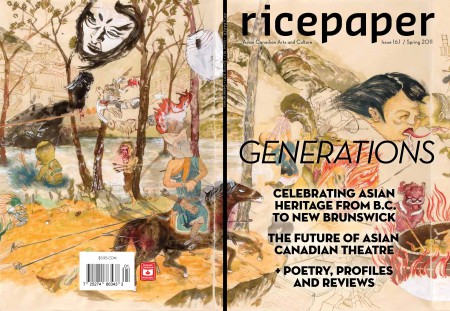An Art Review by Zoë Chan
Published in 16.1
Issue 16.1’s cover featured a portion of a larger art piece, “Forest Romp”, by Howie Tsui. Zoë Chan reviews his Horror Fables exhibition below. You can check out more of Tsui’s work on his website.

Howie Tsui’s art on the cover of 16.1
With a trajectory that reads like a poster boy for today’s global citizen, the Ottawa-based artist Howie Tsui was born in Hong Kong, before moving to Nigeria and then Canada. Unsurprisingly, his art practice is as cosmopolitan in its sources of inspiration as his background, resulting in a playful yet critical intermeshing of diverse aesthetics and mediums. His early career started out heavily informed by North American youth scenes and styles—band posters, graffiti, and street art, as well as aspects of Japanese visual culture—erotica, manga, and anime. More recent work, though still marked by these early pop culture influences, draws heavily from older artistic traditions ranging from the visual iconography of Buddhist hell scrolls to Ming Dynasty figure and landscape painting. Through the lens of his fascination with the supernatural and the surreal, Tsui creates extravagantly strange worlds that seamlessly meld fact and fiction. His artworks are testament not only to his far-reaching imagination and curiosity, but also his personal interest in and engagement with questions surrounding diasporic experience and identity.
Tsui’s hybridized approach to art-making is more than manifest in Horror Fables which evokes ghost stories, family anecdotes, bestiaries, and vampire films. This series, previously presented at the Carleton University Art Gallery and the MAI (Montréal, arts interculturels), will head to Vancouver’s Centre A this summer. Employing formal techniques borrowed from Ming Dynasty scroll painting, Tsui created drawings rendered in ink, paint, and pigment on rectangles of delicate mulberry paper. While his early works may have had a more cartoon-like sensibility with a kid’s rainbow palette, these are delicately drawn with the muted though no less rich colours of century-old works.
Horror Fables is rife with chaotic scenarios situated in a mythical place where mortals and monsters intermingle. A ship afloat on a sea swarming with skeletons and sea creatures. A figure bent over a stream finds his reflection to be a hideous monster. A gruesome creature stirs a boiling pot writhing with creatures within. A man hangs from a tree by a rope around his neck, tongue lolling, while above him a naked woman clings in desperation to a branch using both her teeth and limbs. These uncanny tableaux are operatically epic in scope, teeming with scenes of blood and guts, terror and tragedy. Tsui ups the ante by providing them with an eerie soundtrack made up of re-mixed sounds culled from Hong Kong horror movies. Moreover, he presents these works on paper alongside spectral “portraits” rendered directly on to gallery walls using the residue traces of smoke from matches. Ghostly visages—recalling Edvard Munch’s iconic The Scream—surface from the darkly lit walls; only the burned-out matches left scattered on the floor remind us of their material source.
While stimulating the viewer’s sense of sight and sound within the somewhat sinister atmosphere evoked by Horror Fables, Tsui explores horror through its various facets: as recurring nightmares concocted by our subconscious; as prominent themes in film and folktales; as cautionary tales told to instill good behavior; as generation-old stories bonding families; as strategies to demonize the “Other” within conservative rhetoric; as the traumatically violent events that happen to us or are witnessed on the news; as the tragedies that make up our collective histories, be they natural or man-made, past or present. Yet, as dark as this all sounds, Tsui’s works feel imbibed with the enjoyment he finds in mastering old painting techniques and translating these tangled-up stories onto paper.